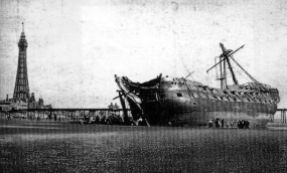
Blackpool was a dangerous place. Gas, electricity, horse-drawn vehicles, motor vehicles, railways, the sea, construction and disease all contributed to an astonishing level of lethality. When the first railway ran between Preston and Fleetwood, enabling visitors to alight at Poulton and travel to Blackpool and starting Blackpool’s rise as a holiday resort a man from Preston died on his return from Fleetwood.
Some of the accidents seem careless by the jaw-droppingly low standards of Victorian health and safety.
 (The wreck of the Foudroyant just to the North of North Pier.)
(The wreck of the Foudroyant just to the North of North Pier.)
The Foudroyant was an eighty gun battleship launched in March 1798. She was named after a French Ship captured by the British. She became Napoleon’s flagship and served in the Mediterranean during the Napoleonic wars. The Neapolitan Royal Family and Lady Emma Hamilton, Lord Nelson’s mistress, were visitors aboard the Foudroyant.
Lord Nelson is the most revered Naval officer. He died at the Battle of Trafalgar at the scene of a decisive British Naval Victory. His last words were: “Kiss me Hardy,” or possibly “Kismet Hardy.” Kismet, fate, was to link the Foudroyant and Mrs Elizabeth Gates.
The Foudroyant had a long career as a training vessel and in 1862 it was sold. There was outrage that it was sold to be broken up by a German shipbreaker. Arthur Conan Doyle, who visited Blackpool later to lecture on his spiritual beliefs wrote a poem in Punch, A wealthy Englishman bought the ship. To offset the cost of repairs it was planned to exhibit it at seaside resorts.
On the 16 June 1897 a storm caused the Foudroyant to smash into the north side of North Pier causing some damage. The crew were all rescued by the lifeboat.
It was impossible to refloat the Foudroyant and it was broken up. A warehouse and shop in Talbot Road was dedicated to making souvenirs from the wreck of the Foudroyant. Souvenirs included ashtrays, chairs, tables, souvenir medallions. Nelson had been a Freemason and a Blackpool Freemason donated gavels (gavels are used in masonic ritual) made from the recovered wood to the Barnard Castle branch of the Masons near where Nelson had joined the Brotherhood. Wood panelling from the Foudroyant adorns the boardroom at Bloomfield Road Football Ground.
The workmen breaking up the wreck had taken to blowing up the pieces to make them easier to gather up and a appreciative crowd gathered on the beach to enjoy the explosion. The wreck was on the beach North of the Metropole Hotel.
Auctioneers and ventriloquists took advantage of the crowds. Workmen had difficulty clearing the crowd when a charge was about to explode.
Mrs Elizabeth Gates had boarded an excursion train from Manchester with her son Victor aged 9 on the morning of Wednesday 15 June, 1898.
They had visited the pier and were on the beach near the Metropole looking at ships at sea when an explosion dislodged a piece of timber with metal inlay weighing over a hundred pounds. It flew into the air and landed on M killing her instantly.
A letter to the paper makes the curious point that Elizabeth was more innocent because she was passing by and had not stopped to watch. Would it been all right if she had stopped to watch and been killed?
Think of poor Victor. He had gone for an exciting train journey with his loving mother to the most exciting place in the world and his mother had been killed walking with him on the beach on an August day.
At the inquest the man in charge of breaking up the wreckage said that the Council had asked him to speed up the process. The verdict was accidental death. The coroner said shrewdly that explosives should not be used on the beach during the season.
In the same week two local lads were drowned near Uncle Tom’s Cabin, a child was killed by a horse-drawn wagon on Central Drive, and three people, two of them fishermen, were drowned at Fleetwood.
Drowning was a frequent event at Blackpool. Many visitors were unfamiliar with the sea and with the tides. On Wednesday July 9th 1930 six boys were drowned between 11 and 11.30 in the morning north of the Manchester Convalescent home or the New Thursby as it is called now, on Clifton Drive, Saint Annes.
(The Manchester Convalescent Home is close to the spot where the boys drowned…there is a track through the sandhills to the beach just to the North of the Home. This is also where Frederick Holt killed Kitty Breaks in 1919.)
91 boys from St Aidans School, Widnes, had been camping for a week. They had gone to the sea to bathe for the first time and at 11.30 the Headmaster blew his whistle and their was a roll-call. Six lads were missing. In a short time six bodies were found. The lads were aged between 14 and 18.
In the vicinity of the mortuary people were disturbed by piercing screams from relatives who had come to identify their loved ones.
That area of the beach is usually safe and all but one of the victims were swimmers. The tide had just turned and fast-running water in channels near the shore had swept the boys away. The spot where the accident happened wasvery close to the spot where Kitty Breaks was murdered by Frederick Holt in 1919.
St Aidans had a colourful history. It was a Catholic borstal or reformatory with roots in the nineteenth century. It had originally used a former naval ship as part of a nautical training regime. One two occasions the ship had been burned by the residents after which it had been land-based in Widnes. More recently it was involved in child abuse scandals.

